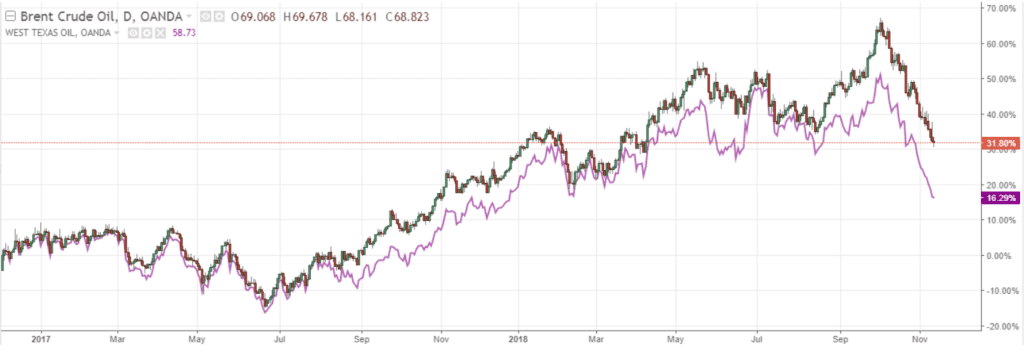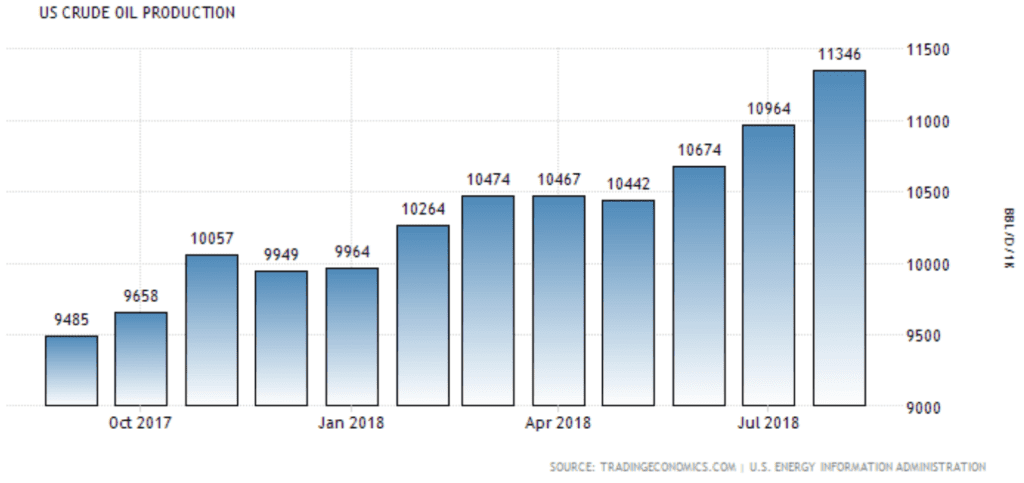Spread trading is defined as simultaneously trading on the changes between two different prices of the same instrument. It occupies a notable segment of the futures market. There are several different types of spreads. Some combinations have attracted enough investors for the market to treat them as separate assets. This created a demand to trade them in a standardized form. Becoming independent instruments causes an options market to form around them. This also allows for easier tracking of their results. Investors have had their eye on the differences in price between the two most iconic assets of the oil futures market (West Texas Intermediate & North Sea Brent Crude) for a long time. It’s no surprise that the Brent WTI spread was one of the first to become its own independent spread instrument.
The basic issue used to be that Brent is a product of the Intercontinental Exchange (ICE) while WTI is a product of the CME group’s NYMEX under the CL symbol. Brent’s often referred to as the barometer of the global oil market. It makes up two-thirds of the world’s crude oil trade. ICE Brent represents the quality of oil extracted from the North Sea and acts as a benchmark for Middle Eastern and Russian oil. Meanwhile, the WTI is the USA’s own oil product. In general, the WTI is of a higher quality than Brent, so it commands a higher price. The differences in global demand for oil and the demand for US oil specifically can sometimes affect this gap in pricing.
Forming The Brent WTI Spread
A key requirement for forming the spread instrument was that individual contracts for both assets each represent one thousand barrels of oil, making the two easier to compare. To trade the spread, you would sell one contract and buy the other. This avoids the risks of the base product’s price swings in favor of capitalizing on the difference in price at the time of striking. For example, one would buy the higher-priced contract and sell the lower if one expects the spread to increase. In the case of an ICE „Brent/WTI spread,” buying one contract actually means one contract for buying WTI and one contract for selling Brent.
Assuming that the price of WTI was higher than that of Brent at the time it’s issued, the price difference becomes positive. On the other hand, when the Brent is valued higher, it leads to a negative difference. It’s amusing to imagine the idea of receiving ten dollars for buying a contract valued at minus ten dollars, although it doesn’t actually work that way. The purchase of said contract wouldn’t lead to a negative cash flow.
Comparing The Two Assets
The price quotes for both products are expressed in increments of 0.01 dollars. This difference forms a permanent minimum difference between the two. Furthermore, the spread carries less risk than the buying and selling of regular oil futures. Both individual assets are subject to the product’s basic price trends and tend to move somewhat similarly to varying degrees. This allows the combined asset to be traded at a lower initial margin. It also bypasses having to use twice the margin for two separate assets. The distance of the spread between the two oil products has historically moved in a range of $0 to -$10 over the past three years. Meanwhile, the price of WTI ranged from $26 to $76 and Brent from $27 to $87 over the same period.

Due to the difference in volatility, the individual assets provide significantly more opportunities for those aiming to do short-term speculative trading. Trading the spread requires an entirely different approach. It relies heavily on a detailed analysis of the fundamentals behind the global oil market. In this case, the emphasis is on discerning the outlook of US oil production and how demand for it will differ from the oil markets of the rest of the world.

The WTI’s price lag is mainly due to the USA’s pursuit of energy independence, as the chart below illustrates.

Global Crude Oil Market
One of Donald Trump’s objectives as President was to deregulate the oil industry. This motivated the sector to increase its production to reach a level of output that could make the country self-sufficient in that area. This effort has been successful in some respects. The latest production figures show that the amount of oil extracted in the US today is the highest in history. This amount would be enough to cover 57% of the domestic market’s demand. Meanwhile, 2017 production levels only covered about 50%. At the same time, the shift towards energy independence also means moving away from the global market. Consequently, the US could become potentially capable of controlling economic processes through regulating its own prices.
Currently, the US has sanctions against both Venezuela and Iran, lowering the global oil supply. At the same time, the Trump administration continues pressuring OPEC countries to increase their production. These circumstances make the uncertainties surrounding the supply of oil arise primarily around sources outside the USA. In the states, high oil prices backed by a strong dollar act as an inflation-inducing effect. This may also partially be why European and Asian countries are averse to raising their low interest rates. Raising them would help them combat the USA’s interest rate advantage at a cost.
Meanwhile, for Trump, weakening the dollar would be necessary to accomplish his other objective of improving the US trade balance. Meanwhile, the WTI is slowly lagging behind Brent in price. This causes rising oil prices to affect US inflation to a lesser (although still notable) extent. The US domestic market balance can be attributed to an economic policy that supports production. This keeps the price of WTI low and creates a larger market for domestic producers. The effect, of course, is the stimulation of the economy.
Final Words About The Brent WTI Spread
In that regard, the USA’s current economic policy aligns well with Trump’s goals. The spread between the two oil products, which stabilized at $10 in recent months, serves the US government’s interests. Rising international tensions could push the price of Brent higher than WTI, which will lead to the spread increasing. The current $10 may seem high, it could still potentially rise to as much as $20 as the US heads towards its 12 million barrels production goal.

